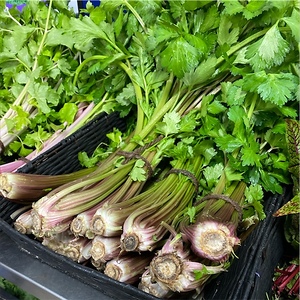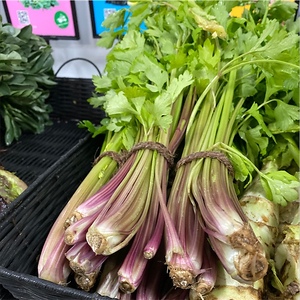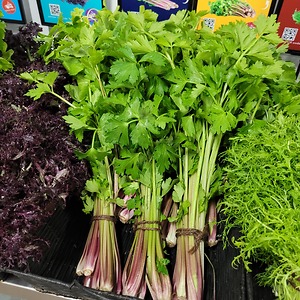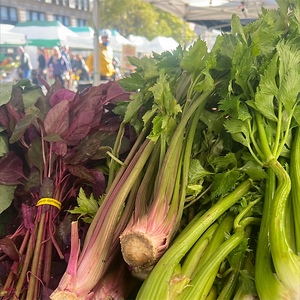

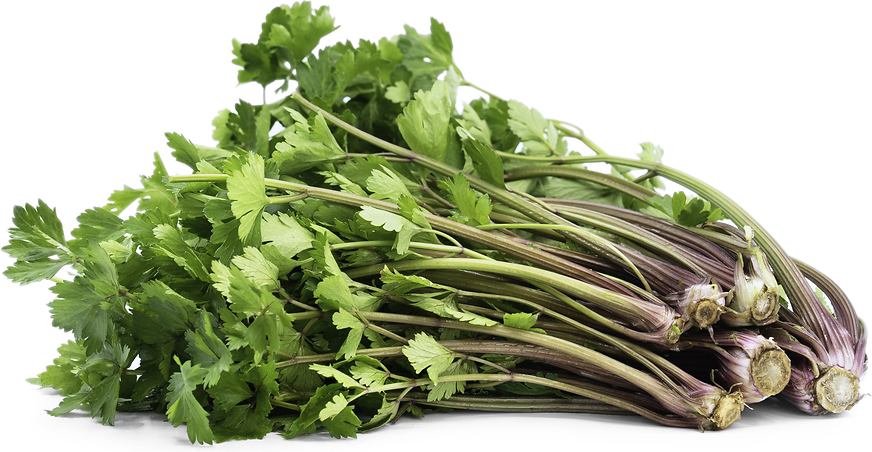
Red Celery
Estimated Inventory, bunch : 0
This item was last sold on : 07/12/24
Description/Taste
Red celery is comprised of elongated, straight, to cylindrical stalks that grow upright from a single base. Each stalk is slightly narrower than commercial green celery varieties and has a ridged surface, connecting into leafy tops with broad, flat, and serrated leaflets. Red celery will vary in color depending on variety, soil, and growing conditions, and generally appears in variegated shades of burgundy, red, purple, and green. The stalks have a firmer, denser consistency than green celery and an aqueous, succulent, and crisp, chewy mouthfeel. Red celery has a rich, earthy, grassy, and herbal flavor, considered more robust than the neutral tones of green celery. It is important to note that some Red celery can develop a slightly bitter flavor if grown in unfavorable conditions.
Seasons/Availability
Red celery can be grown year-round in cooler northern regions and as a late fall and winter crop in warmer climates.
Current Facts
Red celery, botanically classified as Apium graveolens var. dulce, is a general descriptor for several varieties of pigmented celery belonging to the Apiaceae family. The colorful, upright plants are native to Europe and are a specialty type of celery traditionally grown in home gardens. Historically, Red celery was prevalent in Europe and the United States in the 17th and 18th centuries, but over time, green celery varieties began to dominate commercial markets, leading Red celery to become obscure. Red celery generally showcases elongated, straight stalks that are either entirely red or red only at the base, transitioning into purple and green hues towards the top. The plants are typically harvested 100 to 120 days after sowing and are favored by home growers for the plant’s cold tolerance, hardy nature, and easier cultivation than green celery varieties. Red celery is slowly reemerging as a unique culinary ingredient and chefs value the pigmented stalks for their firmer nature, richer flavor, and coloring. The most popular types of Red celery include Giant Red and Redventure.
Nutritional Value
Red celery is a source of vitamin K to assist in faster wound healing, potassium to balance fluid levels within the body, vitamin A to maintain healthy organ functioning, and vitamin C to strengthen the immune system while reducing inflammation. The stalks also contain some anthocyanins, pigments that give the stalks their red hues and provide lower amounts of other nutrients, including folate, riboflavin, calcium, phosphorus, and magnesium.
Applications
Red celery has a rich, earthy, vegetal, and slightly herbal flavor suited for fresh and cooked preparations. The celery’s pungency is determined by soil and growing conditions. Some consumers may find certain Red celery to have a strong flavor unsuitable for fresh preparations, while other consumers enjoy its flavor in salads, used as a garnish, or cut and served with dips. Red celery can also be minced and incorporated into raw side dishes and spreads. In addition to fresh preparations, Red celery is popularly used in cooked dishes as the stalks retain some coloring and hold their shape well due to their firm nature. Red celery can be braised, tossed into soups and stews, or poached and served as a savory accompaniment to roasted meats. The stalks can also be minced into stuffing, chopped into casseroles, or cooked into vegetable medleys. In 18th and 19th century England, celery was often chopped into a slaw, cooked and blended into a sauce, simmered in stews, or blanched and sprinkled with salt. Beyond the stalks, Red celery leaves can be tossed into soups or dried and used as a seasoning over fish, meat, vegetables, and savory main dishes. Red celery pairs well with apples, potatoes, carrots, mushrooms, bell peppers, onions, meats such as pork, poultry, lamb, and beef, fish, and herbs such as parsley, thyme, rosemary, and sage. Whole, unwashed Red celery will keep 2 to 4 weeks when wrapped in foil and stored in the refrigerator’s crisper drawer.
Ethnic/Cultural Info
In the early 19th century, celery was one of the favored vegetables grown for horticultural competitions in the United States. Historically, celery is known as a challenging plant to grow, requiring specific cultivation requirements. The plant’s finnicky reputation led it to become a status symbol among American growers, and over time, growers began to compete to see who could produce the largest celery head. Competitions at county fairs encouraged the growth of massive vegetables, and new celery varieties were created specifically bred to grow to large sizes. Red Giant celery, while no longer traditionally grown to large sizes, was once cultivated to extend to just under one meter in length. These large heads were proudly displayed at fairs throughout the United States for several years. Eventually, consumer demand shifted the grower’s focus back to producing compact, flavorful varieties, but at some agricultural events in the United States in the modern day, the practice of growing massive vegetables still lives on.
Geography/History
Red celery is believed to be a descendant of wild celery plants native to the Mediterranean. Wild celery has been naturally growing since ancient times and was commonly found in moist, fertile soils, along marshes, in ditches, and beside coastlines in cool climates. Experts believe celery seeds were gathered from wild pants and were spread across the Mediterranean into northern Africa and Asia as early as 4,000 BCE. Initially, wild celery was used as a medicinal ingredient, mainly as an aphrodisiac, nerve soother, and for hangovers in ancient Rome and Egypt. The wild stalks were believed to have a bitter, pungent, and unappetizing taste, reserving the plant for use in medicines and as a wreath adorned on the head, made from celery leaves. Over time, wild celery was intentionally bred and selected to improve the plant’s flavor and texture. The exact history of who began cultivating celery is unknown, but it is mostly attributed to the French and Italians sometime around the early 17th century. By the late 17th and early 18th centuries, wild celery was somewhat domesticated into palatable cultivars, consumed in salads among the upper class of Europe. Celery eventually became widespread among the working class and the stalks were favored as a filler in dishes to feed more people without providing additional meat or expensive ingredients. The origin of Red celery is mostly unknown, but the pigmented variety first appeared in records and catalogs during the late 18th century in England. Red Celery also emerged in The American Gardener’s Calendar in 1806, establishing its presence in home gardens in the United States. Today Red celery is a specialty variety mostly grown in home gardens of novelty plant enthusiasts. The variety is not traditionally sold in commercial markets, but it may be produced by select growers for sale at farmers markets in Europe, Asia, Australia, and the United States.



